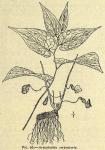 The dried rhizome and roots of Aristolo'chia serpenta'ria Linné (Virginia), and of Aristolochia reticula'ta Nuttall (Texas).
The dried rhizome and roots of Aristolo'chia serpenta'ria Linné (Virginia), and of Aristolochia reticula'ta Nuttall (Texas).
BOTANICAL CHARACTERISTICS.—Stem 8 to 15 inches high, pubescent. Leaves alternate, ovate, or oblong, with a heart-shaped or halberd-shaped base. Flowers all next the root, short-peduncled; calyx-tube bent like the letter S; stamens 6, the sessile anthers adnate to the fleshy style.
HABITAT.—United States (Virginia and Texas).
 DESCRIPTION OF DRUG.—A rhizome about 25 mm. (1 in.) long, and about the thickness of a quill, contorted, bent up and down, externally light grayish-brown, with short stem-bases on the upper side and numerous long, fibrous, branching rootlets below, interlaced; internally grayish, closely matted. The bark is thin, overlaying quite a large woody zone, and separated into wood-wedges by broad medullary rays; the pith is not in the center but is nearer the upper side, making the lower wood-wedges the longest. Odor family terebinthinate, characteristic; taste warm, bitter, and camphoraceous. Virginia and Texas Serpentaria are both recognized by the U.S.P. The latter is about twice as large as the former, with fewer and thicker rootlets.
DESCRIPTION OF DRUG.—A rhizome about 25 mm. (1 in.) long, and about the thickness of a quill, contorted, bent up and down, externally light grayish-brown, with short stem-bases on the upper side and numerous long, fibrous, branching rootlets below, interlaced; internally grayish, closely matted. The bark is thin, overlaying quite a large woody zone, and separated into wood-wedges by broad medullary rays; the pith is not in the center but is nearer the upper side, making the lower wood-wedges the longest. Odor family terebinthinate, characteristic; taste warm, bitter, and camphoraceous. Virginia and Texas Serpentaria are both recognized by the U.S.P. The latter is about twice as large as the former, with fewer and thicker rootlets.
ADULTERATIONS.—As found in commerce, Serpentaria is frequently adulterated with portions of the stem. Hydrastis canadensis has been used as an intentional adulteration; also spigelia. All of these may easily be distinguished from the genuine by their general characteristics.
Powder.—Characteristic elements: See Part iv, Chap. I, B.
CONSTITUENTS.—Volatile oil (½ per cent.), containing borneol, aristolochine, C32H22N2O13 (very bitter), tannin, resin, starch, etc.
Preparation of Aristolochine.—Precipitate decoction with lead acetate; ex. haust precipitate with hot alcohol; evaporate; dissolve out alkaloid with water. It is bitter, yellow, amorphous, or in needles; soluble in alcohol, water, precipitated by tannin.
ACTION AND USES.—Aromatic stimulant and tonic. Its only possible therapeutic virtue is as a stimulant to the gastric mucosa—Wood.
Dose: 5 to 30 gr. (0.3 to 2 Gm.).
Tinctura Cinchonae Composita (2 percent. of serpentaria) 1 to 4 fl. dr. (4 to 15 mils).

